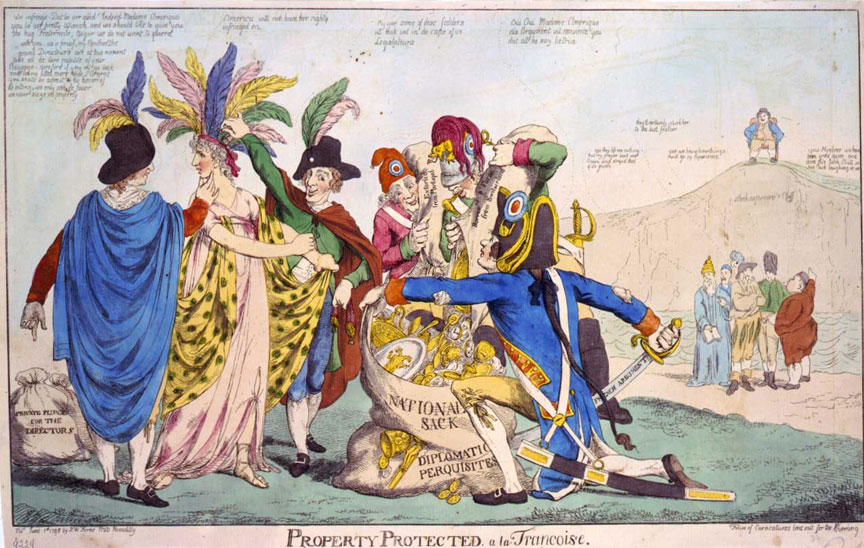XYZ Affair

President Adams sent three envoys to France to negotiate a new agreement. French Minister Talleyrand demanded a personal bribe of $250,000 and loan of $12 million dollars to France. When word of the affair became public, the American people were incensed. They demanded war with France. Adams refrained from declaring war, but a quasi-war too.
Relations between the United States and France had gone steadily downhill since the Genet mission. Tensions were further exacerbated by the Jay Treaty, signed between the United States and Great Britain. In addition, French ships had begun preying on American merchant ships. When Pinckney was sent to France to replace James Monroe, the French refused to receive him. In an attempt to avoid war, Adams agreed to send a special delegation to attempt to negotiate a treaty with France. The delegation included John Marshall, Elbridge Gerry, and Charles Cotesworth Pinckney. The representatives arrived in France and were told they would not be received by the French Foreign Minister Talleyrand unless certain political conditions were met. Furthermore, they were told that, as a precondition to any talks, a bribe would have to be paid to members of the Directorate and a loan given to France. Finally, they were told that they were in danger of arrest. Needless to say, they decided to return home.
When Adams received word of what had happened, he informed the Senate that the mission was unsuccessful. He did not want to release complete information on the meetings, fearing that it would result in a war cry against France. The Republicans did not believe the mission had been unsuccessful and demanded that Adams release the full transcripts of the dispatches from France. They expected to show that France was receptive to an agreement. Finally, Adams, who was being attacked mercilessly, complied and released the complete transcripts. Soon, war fervor was sweeping the nation. Adams did not wish to go war with France, but American ships were being attacked almost as soon as they left New York Harbor. Adams decided to build a navy and give it the task of protecting American ships and attacking French privateers. The Navy was officially established in 1798. Four large frigates, initially authorized by Congress in 1794, were rushed to completion. They were the "Constellation," the "United States," the "Chesapeake," and the "President." They represented the very best in ship design, combining speed and firepower. In addition, cities throughout the eastern seaboard built ships for the government at their own expense. By 1800, the US Navy was fielding a fleet of 49 warships of various sizes. Furthermore, over 100 merchant vessels were armed and authorized not only to defend themselves but to take aggressive actions when possible.
The US Navy was given the task of protecting US ships and attacking French privateers and naval vessels. In the two years of warfare between France and the US, American ships sank or captured nearly 90 French vessels on the high seas. In the most successful sea battle of the war, the USS "Constellation" captured the French naval frigate "L’Insurgent”, reportedly one of France's best vessels. By 1800, the French realized the error of their ways, and agreed to accept an American delegation without precondition. An agreement was swiftly reached, and the hostilities came to an end. For those not at sea, the fighting between France and the US may have seemed like a "quasi-war”, but for those serving in the US Navy or on merchant ships, it was a war in every way that mattered.
 >
>